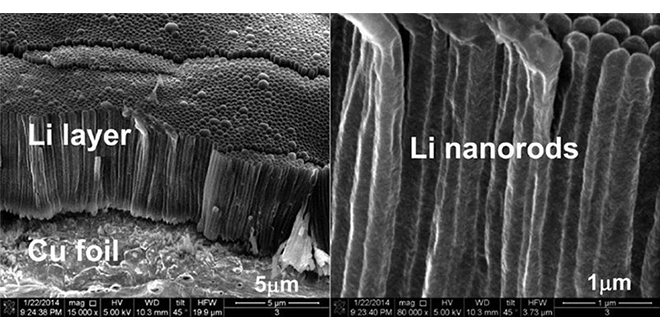There’s a lot of interest in using lithium metal as an anode material, because of its theoretical high capacity of 3,860 mAh g−1 (around ten times that of the graphite anodes used in typical Li-ion batteries). However, it doesn’t measure up in terms of cycle life and safety requirements, and one reason is the formation of dendrites, pesky root-like growths that form on the surfaces of the anodes during cycling.
Researchers at Pacific Northwest National Laboratory (PNNL) report that they have grown dendrite-free lithium films with a self-aligned and highly compacted nanorod structure.
In their paper, Dendrite-Free Lithium Deposition with Self-Aligned Nanorod Structure, which appears in the ACS journal Nano Letters, the team noted that most of the work in suppression of dendrite formation can be divided into three categories:
- Improve the stability and uniformity of the solid electrolyte interphase (SEI) on the Li electrode surface by optimization of solvents salts, and electrolyte additives. However, the SEI alone cannot completely eliminate dendrite formation/growth because of its weak mechanical strength.
- Form alloys of Li and non-Li metal during electrodeposition, which is achieved by adding inorganic compounds or a second salt to the electrolytes. However, most of these metal cation additives will be consumed by forming alloys during Li deposition, so the suppression of Li dendrite formation may not be sustainable.
- Use mechanical barriers to block dendrite growth. However, while such a protective layer acts as an effective physical barrier to block dendrite penetration, it does not alter the growth mechanism of Li dendrites on a fundamental level. As a result, porous Li may still be generated beneath the physical barrier and lead to a rapid increase in the impedance of the Li anode and battery failure even without a dendrite-related short.
“In this work, we further investigated the evolution of the cross-sectional morphologies of such Li films during deposition/stripping cycles,†write Yaohui Zhang and his colleagues. “The effects of Cs+ and other components in electrolytes on the voltage profiles of electrochemical deposition and the chemistry of the SEI formed on copper substrates prior to Li deposition are systematically investigated. It is revealed for the first time that the apparently dense Li films grown in the presence of CsPF6 additive actually consist of self-aligned, highly compacted nanorods. We also found that, before the reductive decomposition of carbonate solvents at about 0.9−1.2 V, a thin SEI has already formed on the Cu surface at about 2.05 V vs Li/Li+. The quality of this underlying SEI predecessor would essentially dictate the morphologies of the Li to be deposited.â€
“The new understanding on the internal microstructure of the dendrite-free Li films deposited electrochemically, their structural evolution during stripping/deposition processes, and the synergistic effect of Cs+ additive and preformed underlying SEI on Li deposition will help researchers in this field design new approaches to enable a metallic Li anode, the ‘Holy Grail’ of Li-based battery chemistries.â€
Source: ChargedEVs


